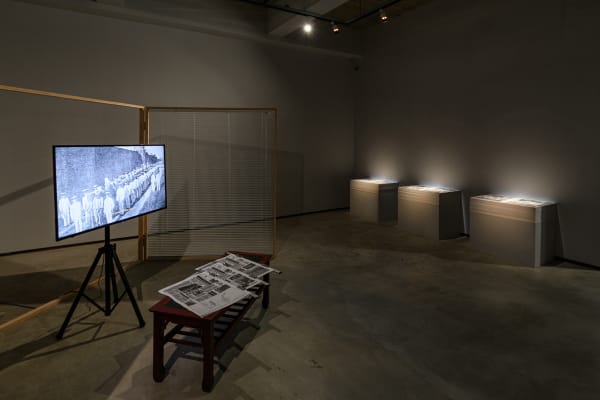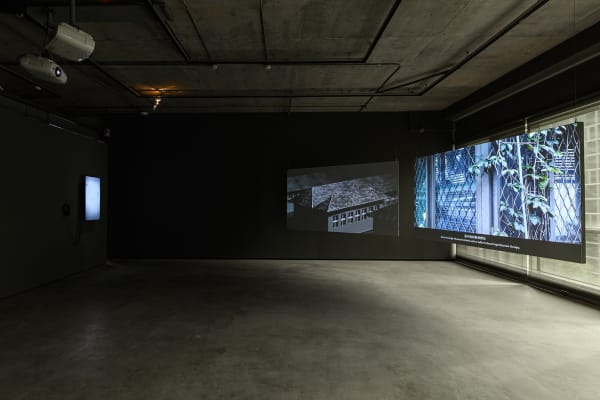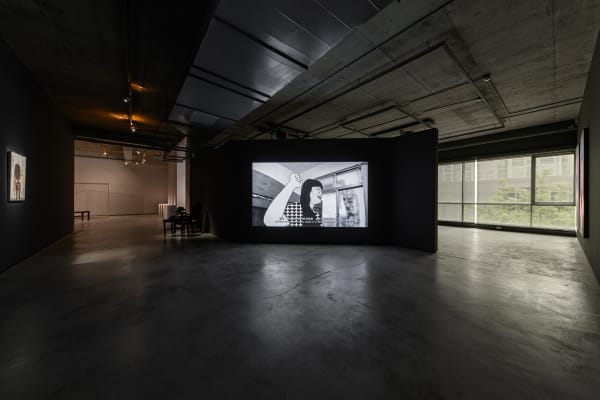Into the Crevices of Imagination: Curated by WEI Rong Da
Dates
28 SEPTEMBER - 17 NOVEMBER 2019
Reception
28 SEPTEMBER, 4:30 p.m.
TKG+ Projects 2F, No.15, Ln. 548, Ruiguang Rd., Neihu Dist., Taipei 114, Taiwan
Artists
Chen Che Wei, Chang Wen Hsuan, and Hsu Che Yu
Curated by
WEI Rong Da
The word “crevices” in the title of the exhibition refers to a scene in The Matrix (1999)in which Neo accepts the invitation from Morpheus, and, before leaving the Matrix, sees cracks in the mirror. The blue and red pills stand for Neo’s choices and conceivable possibilities of his life, whereas the cracked mirror next to him hints his awareness of the reality. What leads Neo out of the fantasy is not the broken mirror but an agency resulted from the act of imagining (the chosen pill). It propels him and the audience to imagine a heterogeneous reality other than this. However, when the mirroring fantasy created by the Matrix envelopes people, the system would relentlessly debug and expel anomalies harmful to the operation of the system in order to maintain its stability/fidelity. In real society where we live, a system similar to the Matrix also operates in a comparable manner. Much like the mirror in the film, baselines are set to test and to discipline people in the system. Through means of national narratives and the media, taboos are integrated into moral values and public opinions in order to exercise control, remove latent foreign objects, and exclude the Other, so that the so-called norm is constantly being consolidated.
Under the proposition, biopolitics is seen as a set of techniques which can be transferred, reproduced, or re-exercised. To build a stable system, society as a collectivity ejects and suppresses the Other and foreign objects, like a man-made system with debug mechanism. The mechanism renders differences indiscernible to the eye of those who are within the system, shrouds them in fantasy, and subjects their value system to a certain ideology.
When the state apparatus presides over history and exercises the power of discourse over contemporary matters via the media, memories and judgments of individuals are constrained under influences of a certain ideology. The forms of memory is a hidden motif underlying this exhibition, interlinking the works of the three artists. Chen Che Wei, Chang Wen Hsuan, and Hsu Che Yu investigate foreign matter buried in reality via different means, from investigation, deduction, to writing. They all use fiction to reproduce their inquiries in artistic forms. Fiction, however, can possibly reveal more truth.
Author Wu Ming-Yi once said in his novel,The Stolen Bicycle (2015), in the voice of the protagonist, “I often feel that a novelist uses three pillars of truth to get the reader to believe in seven pillars of fiction and enter the castle he or she has created in language, whether it is opulent, squalid, fantastical or unreal.”[1]In the book, Wu Ming-Yi creates a complicated multilayered narration to demonstrate interplay between text and reality through interactions between characters in the book and the reader. According to Wu’s concept, the imaginary/suspended space provided by art is the truth within the hybrid of reality and fiction. As society predominates most of our value systems, this imaginary and suspended space becomes an important remaining possibility for the subjectivity of each individual. With the help of the fictionality of art, how can we rediscover what is buried beneath systematic norms? The act of imagining, or doubting, is a significant function which art offers to society. The proposition of the exhibition puts forward a hypothesis: If art retains its function and responsibility in society, how does it, with its intrinsic fictionality, empower people to cast doubts on reality? When the function of art is assimilated into the structural operation of societal collectivity, is it possible for the context that art has constructed/reconstructed to identify the crevices of fantasy, and to further provoke an awareness of what lies amidst them? By clandestinely employing texts seen as taboo or heresy by society, a propelling agency to call things into question before and behind the facade is proffered.
The crevices of fantasy have always been part of our daily life. It is merely because of the operation of the state and social system that they remain inconspicuous. TitledInto the Crevices of Imagination, this exhibition suggests that artworks be a tool of identification and imagination to identify the heterogeneity concealed by the system’s operative framework, to recognize the systemic manipulation on individuals and their memory, and to further imagine a coexistence with the heterogeneous outside the system.
CHEN Che Wei (b. 1986)
Chen Che Wei’s recent works share a strong focus on patients with mental disorders who have been neglected and excluded from society throughout the course of modernization. The exploitation of the autonomy of humanity by the state institution illustrates the power structures and politics which are rendered invisible in the social system. Based on “Yang-Shen-Yuan,” a mental asylum founded in the 1930s, Chen Che Wei has developed such works as Notes on Oblivion, Body Not Mine, and Dual Portraits(all 2016), highlighting a modernization process with health and hygiene strategies as the foundation of colonial rule. The state power excludes and confines abnormal individuals for the community’s general well-being. Humans are then scientifically reduced to objects subjugated to control and protection in this system. Society is further convinced that it is a necessary measure; hence the oblivion and negligence.
CHANG Wen Hsuan (b. 1991)
Storytelling is a primary technique in Chang Wen Hsuan’s recent works. Through various types of fictional writings, Chang questions the historical reality, its relations to individuals, and the interrelations among individuals who are within this reality. While fictional texts allow individuals to flee the influence of historical judgments, the politics of writing inevitably generates another inescapable layer of referentiality. The Structure of Taiwanese Histories, on view in this exhibition, is a new edition re-initiated by Chang in 2017. In this edition, the use of “tsioh-miâ” is emphasized over a complicated index structure. The artist replaces names of historical characters with metaphors, erasing the faces of the characters in the story. By doing so, the interplay between hierarchy and historical interpretation is foregrounded. The agency of individuals under historical and political circumstances is then reconstructed through the artist’s intricate multilayered narratives.
HSU Che Yu (b. 1985)
One after another, the illustrated 2-dimensional figures in Hsu Che Yu’s works are like memorial portraits. Inspired by his daily life, Hsu weaves trivial occurrences together, and redirects the work to a specific subject matter of his interest, memory — how things are remembered, and how cognitive models work. In the series “Microphone Test,” the suicide incidents of authors Huang Guojun and Yuan Zhesheng adumbrate the theme of death. The narration is interlaced with interactions between the artist and several friends often seen in his work, revealing his raw private life on screen through the seemingly nonsensical script. The flattened figures in turn morph into characters in a fictional screenplay that ultimately cloaks the truth.

















